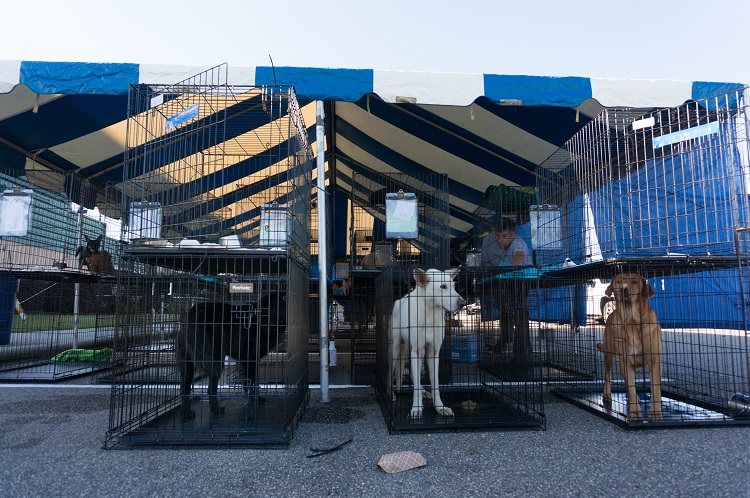Recent studies have shown that pets have the ability to relieve stress, provide purpose, and give unconditional love and support to those who need them. This profound connection is referred to as the “human-animal bond.” During an emergency or disaster, this bond is exhibited with the great lengths people go to both remain with and save their pets, including putting themselves and others at risk. A new tool addresses this gap.
 Based on experiences during disaster responses, members of the American Society for the Prevention of Cruelty to Animals (ASPCA) have observed a high likelihood of people not evacuating without their pets. For this reason, it is essential to consider pets in state and county disaster plans, and include these members of the family in disaster response efforts. An integral part of helping people in disasters is helping their pets. A new tool is designed to help jurisdictions assess animal response capabilities and identify ways to address any gaps.
Based on experiences during disaster responses, members of the American Society for the Prevention of Cruelty to Animals (ASPCA) have observed a high likelihood of people not evacuating without their pets. For this reason, it is essential to consider pets in state and county disaster plans, and include these members of the family in disaster response efforts. An integral part of helping people in disasters is helping their pets. A new tool is designed to help jurisdictions assess animal response capabilities and identify ways to address any gaps.
Human-Animal Bond
The American Veterinary Medical Association (AVMA) notes that, due to a lack of more traditional support systems in modern society, for many people, companion animals are the sole source of emotional and social support. Companion animals provide significant psychological and physical health benefits, especially to children, the elderly, the disabled, the mentally and physically ill, and the incarcerated. Given this bond, AVMA believes that, “when disasters strike, saving animals means saving people.”
Without question, human-animal bond dynamics influence people’s responses in disaster situations – causing them to behave in ways that put themselves, responders, and others at risk. In his November 2000 paper, “A Study of Pet Rescue in Two Disasters,” Sebastian E. Heath of the Department of Veterinary Clinical Science at Purdue University found that up to an 80% reduction in premature reentry into evacuated areas could be achieved if pets were evacuated with their owners. He noted that, of those who rescued their pets, 65% felt it was worth risking their lives to do so, and that having children or having more than one pet greatly increased the likelihood of rescue. Based on his findings, he strongly recommends the full integration of animal welfare groups and responders into emergency planning, so they can be an integral part of all evacuations and responses to mitigate these risks. Providing care for animals during an emergency may facilitate the personal safety and care of a large segment of the human population.
First Responders Save Lives
In the ASPCA’s disaster response work, most animal emergencies occur within the first 24-48 hours of disaster onset, which means that local responders often perform the initial search, rescue, and sheltering activities. It typically takes state and national responders 24-48 hours to arrive and assist with search and rescue activities. Enhancing animal response capabilities through an established, skilled, and actively engaged Community/County Animal Response Team (CART) that is recognized by emergency management and supports animal control efforts saves lives. These responders provide an invaluable service to emergency management and to their communities. Their unique resources and expertise in managing animal populations are critically important to governmental and nongovernmental agencies charged with responding to and managing human and animal populations in a disaster.
Animal response teams should recognize that rescuing humans is always the first priority, with animal search and rescue occurring only when it is safe and does not interfere with human rescue activities. However, it is not always possible to clearly separate human rescue and animal rescue operations, especially when communities do not include animals in their evacuation and sheltering plans. With appropriate planning and training, animal rescue organizations can safely assume animal rescue responsibilities, while other first responders are focused on rescue activities for humans. Often, they may work in tandem.

Animal Emergency Preparedness Checklist
In 2016, the ASPCA developed a three-pronged approach to build animal response capabilities nationwide. The first step was to conduct a national survey, the National Capabilities for Animal Response in Emergencies, to determine strengths and weaknesses at the county and state levels. The survey concentrated on state and local animal response teams and their capabilities, as well as the availability and access to the equipment and supplies needed to respond to animals in disasters. The second step was to develop a preparedness checklist that would assist agencies in identifying best practices for developing response capabilities in the community. The final step is to provide assistance through grants, training, and subject matter expertise to requesting agencies located in strategic areas throughout the country that are seeking to enhance animal response capabilities. The Animal Emergency Preparedness Checklist was developed after watching so many communities struggle to handle animal issues following a disaster.
Experiences during disaster responses showed that jurisdictions simply did not have a structure in place to address rescue and sheltering challenges. The concern was validated with the survey and with agencies having primary jurisdictional responsibilities for animals in emergencies requesting subject matter expertise assistance with planning for and responding to emergencies (specific to animals) in their communities. Based on conversations with emergency managers about what their needs were and areas where they felt they fell short, the checklist was developed.
To ensure that important areas of focus were not overlooked, the checklist was reviewed with subject matter experts and strategic partners throughout the country. It was then tested in a number of small and large communities across the country. The checklist can be used as an analysis tool, as a blueprint for improvements, or as a road map to building animal response plans. The checklist helps identify where a community is well resourced and where additional support may be needed in six key areas:
- Essential Infrastructure
- Organization & Leadership
- Written Plan Elements
- Equipment & Systems
- Rescue, Sheltering & Reunification
- Personnel, Volunteers & Training
Agencies that are in the initial stages of planning for animals in emergencies can utilize the designated high-priority items as areas to begin.
An initial strategic area to concentrate on is identifying and including planning partners that play roles in disasters, including but not limited to: fire, law enforcement, animal control, agriculture, animal welfare groups, and organizations charged with sheltering such as the Red Cross. By including these organizations in initial discussions, the planning process and final outcome become a collaborative effort and provide better awareness and buy-in from the related emergency response agencies. The written plan guides all of the elements of preparedness and response: mutual aid agreements, search and rescue, sheltering, equipment, supplies, and personnel. Collaboration with partners in this process ensures these areas are addressed.
Equally important to the written plan is establishing co-located shelter locations and equipment caches. The checklist suggests a cache of equipment and supplies to support sheltering for a minimum of 50 small animals and 50 large animals. The equipment necessary for small and large animals is vastly different, thus planning partners with experience in small and large animal sheltering can provide valuable input.
Ensuring adequate animal response capabilities means recruiting, training, and equipping volunteers in the community to support the operation. Having an already identified agency or group to provide sheltering support is central to rapidly standing up sheltering operations once evacuations begin and search-and-rescue operations are underway. The goal is to have the capabilities and resources to provide shelter and care for 50 animals for 72 hours. This is where agreements with other counties, rescue groups, and national nongovernmental agencies are so valuable.
Conclusion
For many households, animals are recognized as members of the family. Consequently, when disasters strike, emergency management must manage both human and animal issues. The Animal Emergency Preparedness Checklist was developed to provide communities with a method for identifying animal response strengths and weaknesses and to provide a roadmap for ultimately enhancing response capabilities. It would be most effective when the whole community is engaged in the process. The ultimate goal of the checklist is to build community resources and capabilities that enable communities to effectively and safely manage animals in disasters, thus building stronger, more disaster resilient communities.
To learn more about the NCARE Survey and the Animal Emergency Preparedness Checklist, please visit http://aspcapro.org/about-ncare-survey
